2006 INFINITI M35 torque
[x] Cancel search: torquePage 1278 of 5621
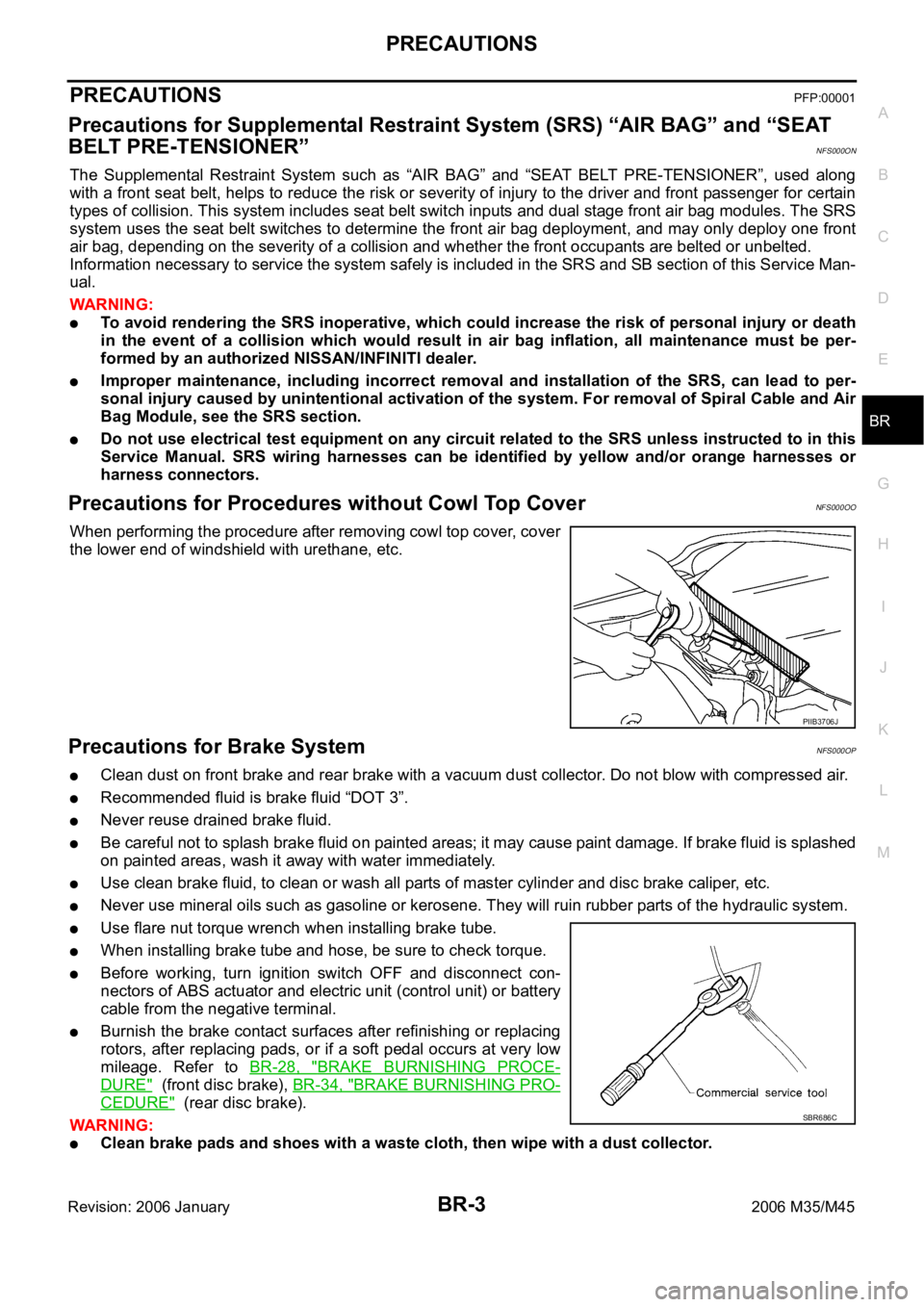
PRECAUTIONS
BR-3
C
D
E
G
H
I
J
K
L
MA
B
BR
Revision: 2006 January2006 M35/M45
PRECAUTIONSPFP:00001
Precautions for Supplemental Restraint System (SRS) “AIR BAG” and “SEAT
BELT PRE-TENSIONER”
NFS000ON
The Supplemental Restraint System such as “AIR BAG” and “SEAT BELT PRE-TENSIONER”, used along
with a front seat belt, helps to reduce the risk or severity of injury to the driver and front passenger for certain
types of collision. This system includes seat belt switch inputs and dual stage front air bag modules. The SRS
system uses the seat belt switches to determine the front air bag deployment, and may only deploy one front
air bag, depending on the severity of a collision and whether the front occupants are belted or unbelted.
Information necessary to service the system safely is included in the SRS and SB section of this Service Man-
ual.
WAR NING :
To avoid rendering the SRS inoperative, which could increase the risk of personal injury or death
in the event of a collision which would result in air bag inflation, all maintenance must be per-
formed by an authorized NISSAN/INFINITI dealer.
Improper maintenance, including incorrect removal and installation of the SRS, can lead to per-
sonal injury caused by unintentional activation of the system. For removal of Spiral Cable and Air
Bag Module, see the SRS section.
Do not use electrical test equipment on any circuit related to the SRS unless instructed to in this
Service Manual. SRS wiring harnesses can be identified by yellow and/or orange harnesses or
harness connectors.
Precautions for Procedures without Cowl Top CoverNFS000OO
When performing the procedure after removing cowl top cover, cover
the lower end of windshield with urethane, etc.
Precautions for Brake SystemNFS000OP
Clean dust on front brake and rear brake with a vacuum dust collector. Do not blow with compressed air.
Recommended fluid is brake fluid “DOT 3”.
Never reuse drained brake fluid.
Be careful not to splash brake fluid on painted areas; it may cause paint damage. If brake fluid is splashed
on painted areas, wash it away with water immediately.
Use clean brake fluid, to clean or wash all parts of master cylinder and disc brake caliper, etc.
Never use mineral oils such as gasoline or kerosene. They will ruin rubber parts of the hydraulic system.
Use flare nut torque wrench when installing brake tube.
When installing brake tube and hose, be sure to check torque.
Before working, turn ignition switch OFF and disconnect con-
nectors of ABS actuator and electric unit (control unit) or battery
cable from the negative terminal.
Burnish the brake contact surfaces after refinishing or replacing
rotors, after replacing pads, or if a soft pedal occurs at very low
mileage. Refer to BR-28, "
BRAKE BURNISHING PROCE-
DURE" (front disc brake), BR-34, "BRAKE BURNISHING PRO-
CEDURE" (rear disc brake).
WAR NING :
Clean brake pads and shoes with a waste cloth, then wipe with a dust collector.
PIIB3706J
SBR686C
Page 1279 of 5621
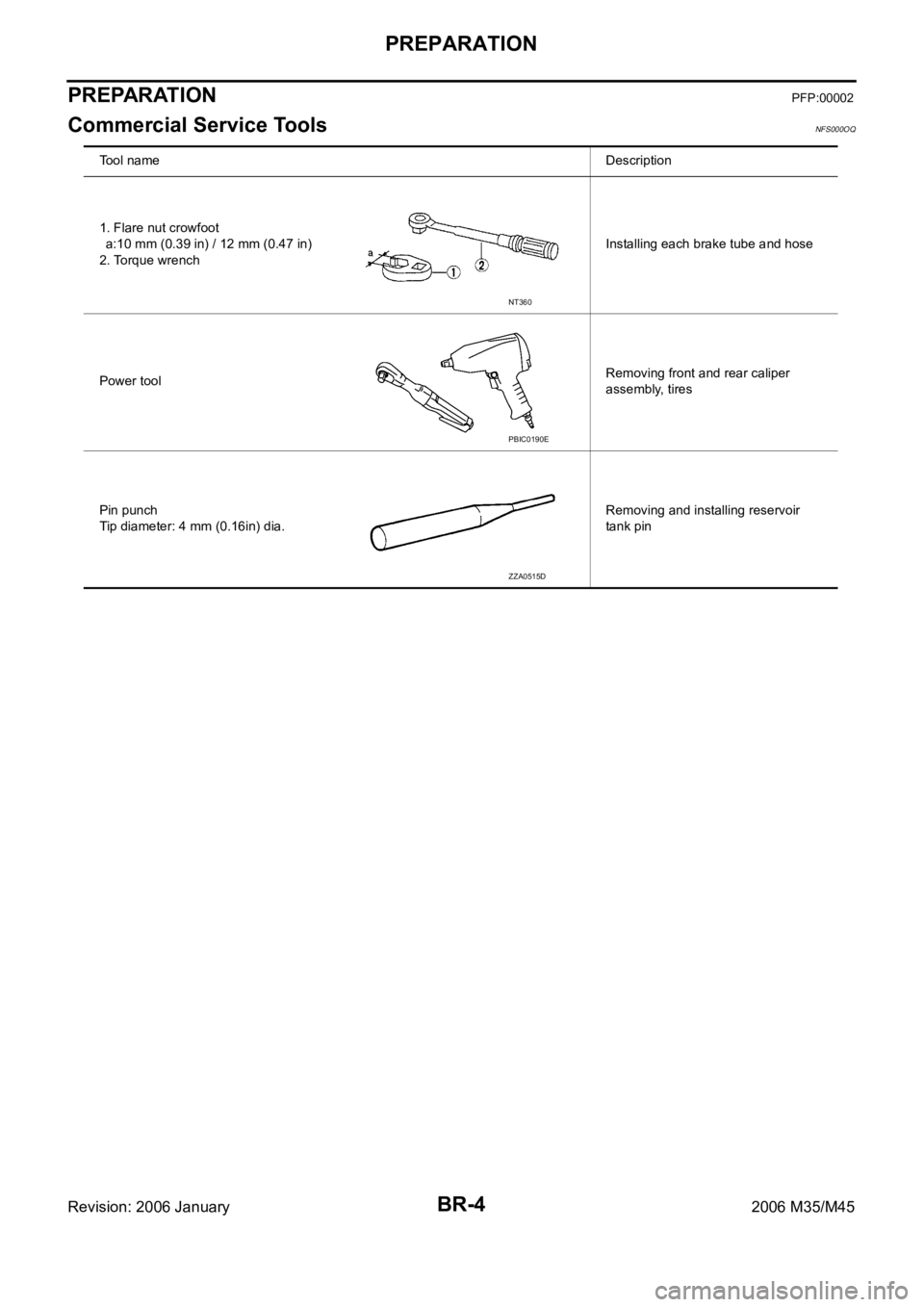
BR-4
PREPARATION
Revision: 2006 January2006 M35/M45
PREPARATIONPFP:00002
Commercial Service ToolsNFS000OQ
Tool nameDescription
1. Flare nut crowfoot
a:10 mm (0.39 in) / 12 mm (0.47 in)
2. Torque wrenchInstalling each brake tube and hose
Power toolRemoving front and rear caliper
assembly, tires
Pin punch
Tip diameter: 4 mm (0.16in) dia.Removing and installing reservoir
tank pin
NT360
PBIC0190E
ZZA0515D
Page 1282 of 5621
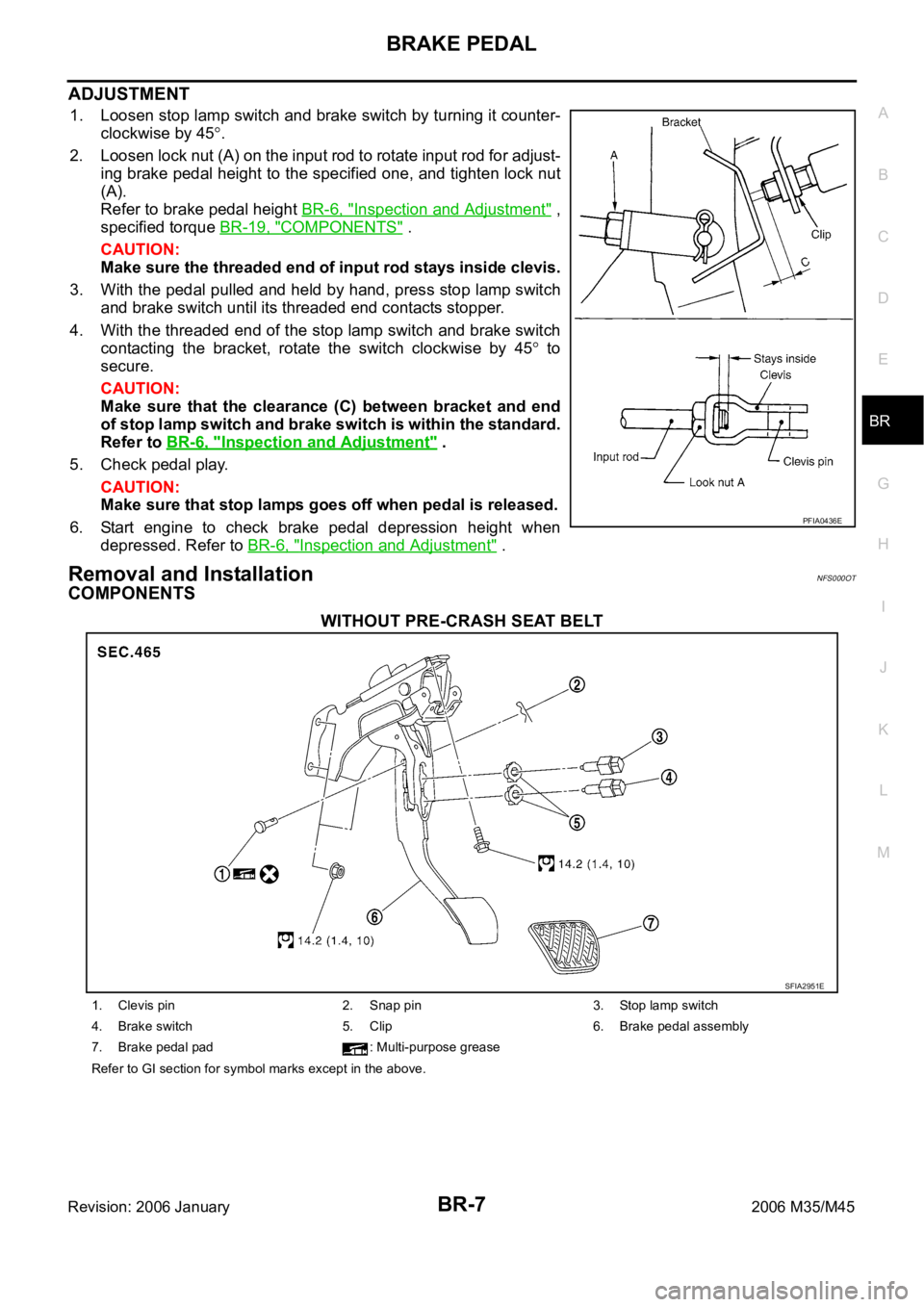
BRAKE PEDAL
BR-7
C
D
E
G
H
I
J
K
L
MA
B
BR
Revision: 2006 January2006 M35/M45
ADJUSTMENT
1. Loosen stop lamp switch and brake switch by turning it counter-
clockwise by 45
.
2. Loosen lock nut (A) on the input rod to rotate input rod for adjust-
ing brake pedal height to the specified one, and tighten lock nut
(A).
Refer to brake pedal height BR-6, "
Inspection and Adjustment" ,
specified torque BR-19, "
COMPONENTS" .
CAUTION:
Make sure the threaded end of input rod stays inside clevis.
3. With the pedal pulled and held by hand, press stop lamp switch
and brake switch until its threaded end contacts stopper.
4. With the threaded end of the stop lamp switch and brake switch
contacting the bracket, rotate the switch clockwise by 45
to
secure.
CAUTION:
Make sure that the clearance (C) between bracket and end
of stop lamp switch and brake switch is within the standard.
Refer to BR-6, "
Inspection and Adjustment" .
5. Check pedal play.
CAUTION:
Make sure that stop lamps goes off when pedal is released.
6. Start engine to check brake pedal depression height when
depressed. Refer to BR-6, "
Inspection and Adjustment" .
Removal and InstallationNFS000OT
COMPONENTS
WITHOUT PRE-CRASH SEAT BELT
PFIA0436E
SFIA2951E
1. Clevis pin 2. Snap pin 3. Stop lamp switch
4. Brake switch 5. Clip 6. Brake pedal assembly
7. Brake pedal pad : Multi-purpose grease
Refer to GI section for symbol marks except in the above.
Page 1284 of 5621
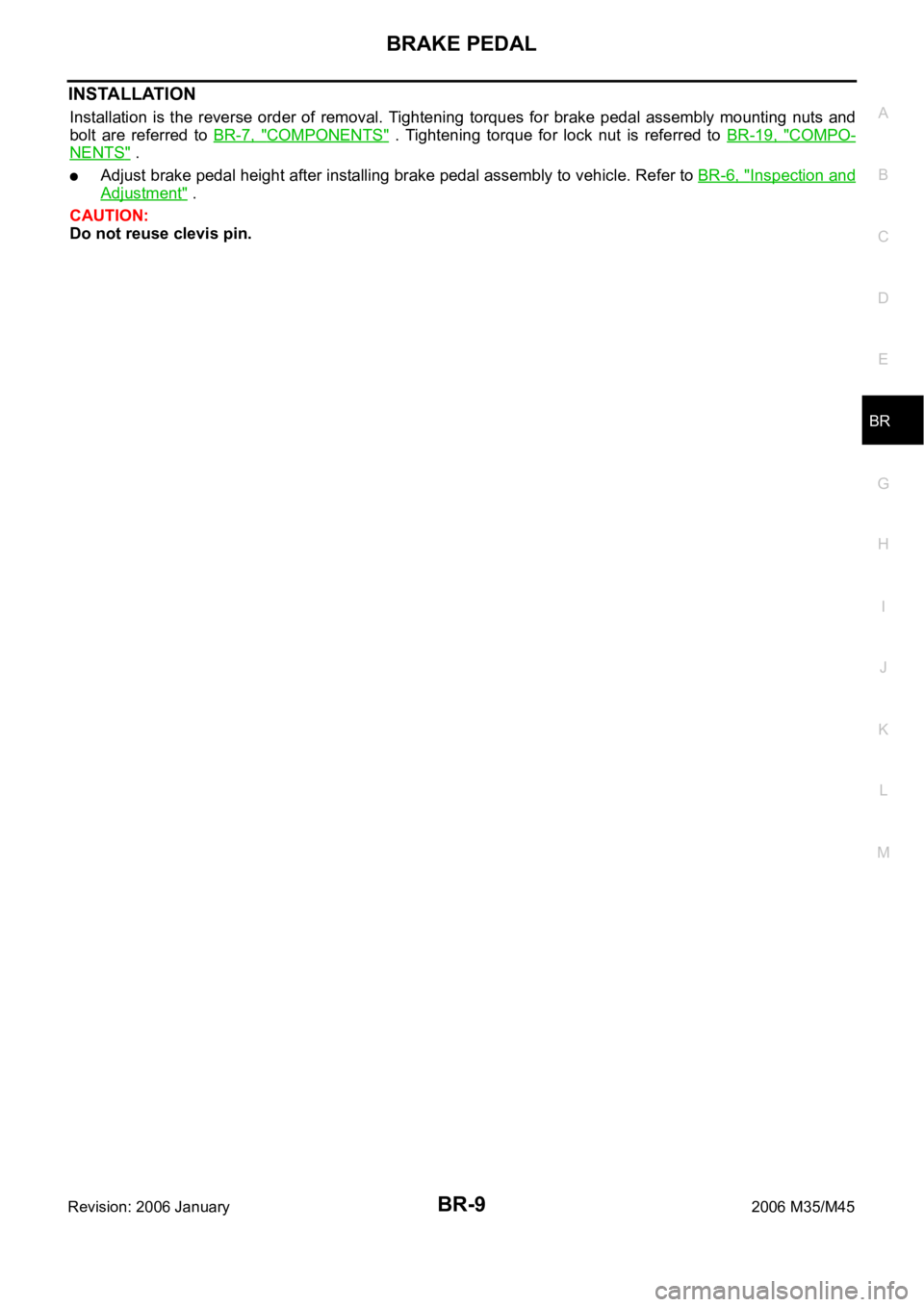
BRAKE PEDAL
BR-9
C
D
E
G
H
I
J
K
L
MA
B
BR
Revision: 2006 January2006 M35/M45
INSTALLATION
Installation is the reverse order of removal. Tightening torques for brake pedal assembly mounting nuts and
bolt are referred to BR-7, "
COMPONENTS" . Tightening torque for lock nut is referred to BR-19, "COMPO-
NENTS" .
Adjust brake pedal height after installing brake pedal assembly to vehicle. Refer to BR-6, "Inspection and
Adjustment" .
CAUTION:
Do not reuse clevis pin.
Page 1286 of 5621
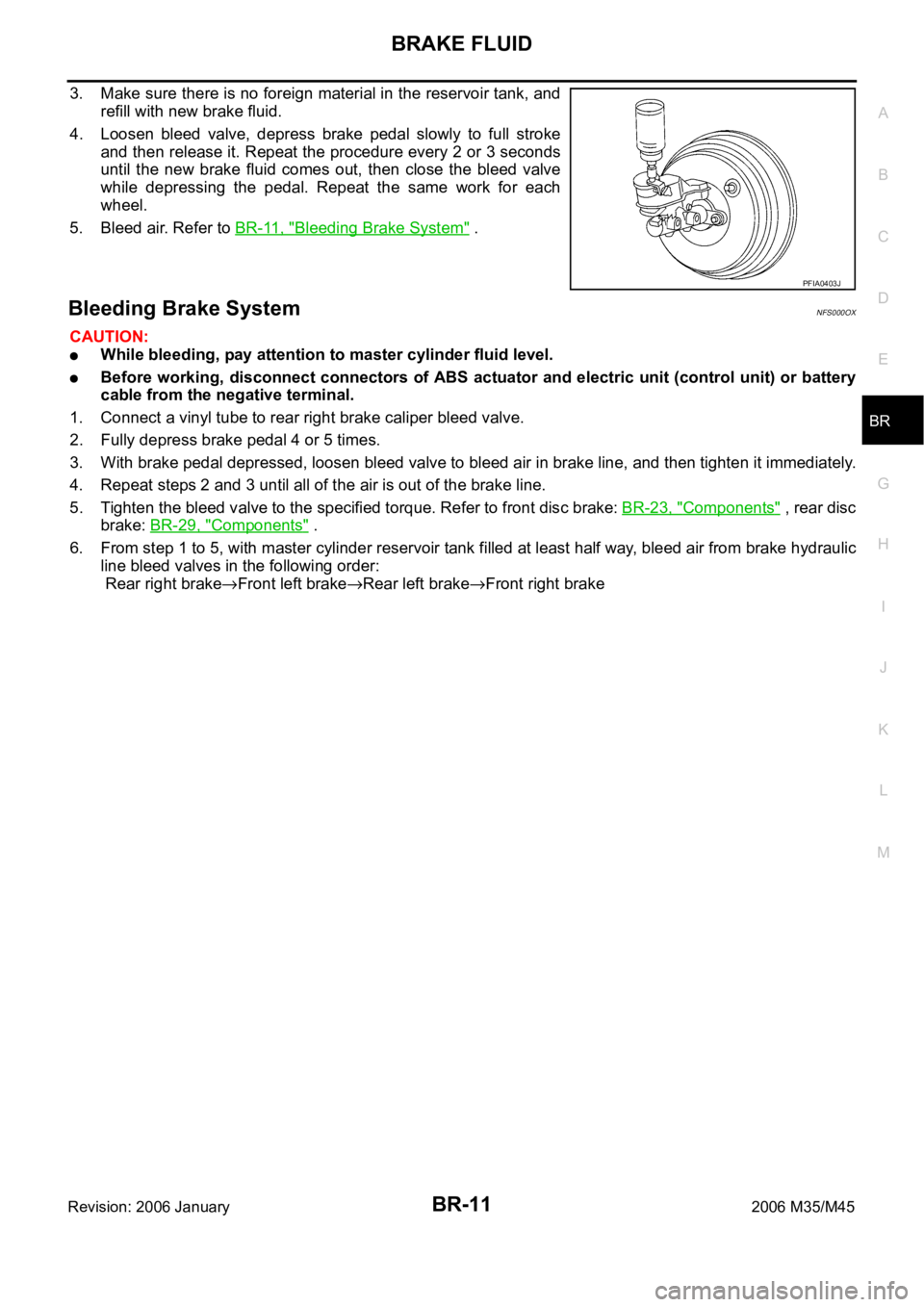
BRAKE FLUID
BR-11
C
D
E
G
H
I
J
K
L
MA
B
BR
Revision: 2006 January2006 M35/M45
3. Make sure there is no foreign material in the reservoir tank, and
refill with new brake fluid.
4. Loosen bleed valve, depress brake pedal slowly to full stroke
and then release it. Repeat the procedure every 2 or 3 seconds
until the new brake fluid comes out, then close the bleed valve
while depressing the pedal. Repeat the same work for each
wheel.
5. Bleed air. Refer to BR-11, "
Bleeding Brake System" .
Bleeding Brake System NFS000OX
CAUTION:
While bleeding, pay attention to master cylinder fluid level.
Before working, disconnect connectors of ABS actuator and electric unit (control unit) or battery
cable from the negative terminal.
1. Connect a vinyl tube to rear right brake caliper bleed valve.
2. Fully depress brake pedal 4 or 5 times.
3. With brake pedal depressed, loosen bleed valve to bleed air in brake line, and then tighten it immediately.
4. Repeat steps 2 and 3 until all of the air is out of the brake line.
5. Tighten the bleed valve to the specified torque. Refer to front disc brake: BR-23, "
Components" , rear disc
brake: BR-29, "
Components" .
6. From step 1 to 5, with master cylinder reservoir tank filled at least half way, bleed air from brake hydraulic
line bleed valves in the following order:
Rear right brake
Front left brakeRear left brakeFront right brake
PFIA0403J
Page 1288 of 5621

BRAKE TUBE AND HOSE
BR-13
C
D
E
G
H
I
J
K
L
MA
B
BR
Revision: 2006 January2006 M35/M45
CAUTION:
All brake hoses and tubes must be free from excessive bending, twisting and pulling.
Make sure that there is no interference with other parts when turning steering both clockwise and
counterclockwise.
Brake tubes and hoses are an important safety part. Always disassemble the parts and retighten
their fittings, if a brake fluid leak is detected. Replace applicable part with a new one, if damaged
part is detected.
Be careful not to splash brake fluid on painted areas; it may cause paint damage. If brake fluid is
splashed on painted areas, wash it away with water immediately.
Cover the open end of brake tubes and hoses when disconnecting to prevent entrance of dirt.
Refill with new brake fluid “DOT 3”.
Never reuse drained brake fluid.
Removal and Installation of Front Brake Tube and Brake Hose NFS000OZ
REMOVAL
1. Drain brake fluid. Refer to BR-10, "Drain and Refill" .
2. Disconnect brake hose from brake tube, using a flare nut wrench.
3. Remove union bolt and remove brake hose from caliper assem-
bly.
4. Remove lock plate and remove brake hose from vehicle.
INSTALLATION
1. Assemble the union bolt and copper washer to the brake hose.
CAUTION:
Do not reuse copper washer.
2. Install brake hose by aligning with the protrusion on brake caliper assembly, and tighten union bolt to the
specified torque. Refer to BR-12, "
Hydraulic Circuit" .
3. Connect brake hose to brake tube, partially tighten flare nut by hand as much as possible, then secure it
to the bracket with lock plate.
4. Using a flare nut torque wrench, tighten flare nut to the specified torque. Refer to BR-12, "
Hydraulic Cir-
cuit" .
5. Refill brake fluid and bleed air. Refer to BR-11, "
Bleeding Brake System" .
Removal and Installation of Rear Brake Tube and Brake Hose NFS000P0
REMOVAL
1. Drain brake fluid. Refer to BR-10, "Drain and Refill" .
2. Disconnect brake hose from brake tube, using a flare nut wrench.
A. With out ICC B. With ICC 1. Front disc brake
2. Master cylinder 3. Brake booster 4. Rear disc brake
5. ABS actuator and electric unit (con-
trol unit)6. Connector 7. Brake hose
8. Brake tube : Flare nut
:18.2 Nꞏm (1.9 kg-m, 13 ft-lb): Flare nut
: 16.2 Nꞏm (1.7 kg-m, 12 ft-lb)
: Union bolt
:18.2 Nꞏm (1.9 kg-m, 13 ft-lb): Connector mounting bolt
: 7.0 Nꞏm (0.7 kg-m, 62 in-lb)
Refer to GI section for symbol marks in the figure.
SFIA2964E
Page 1289 of 5621
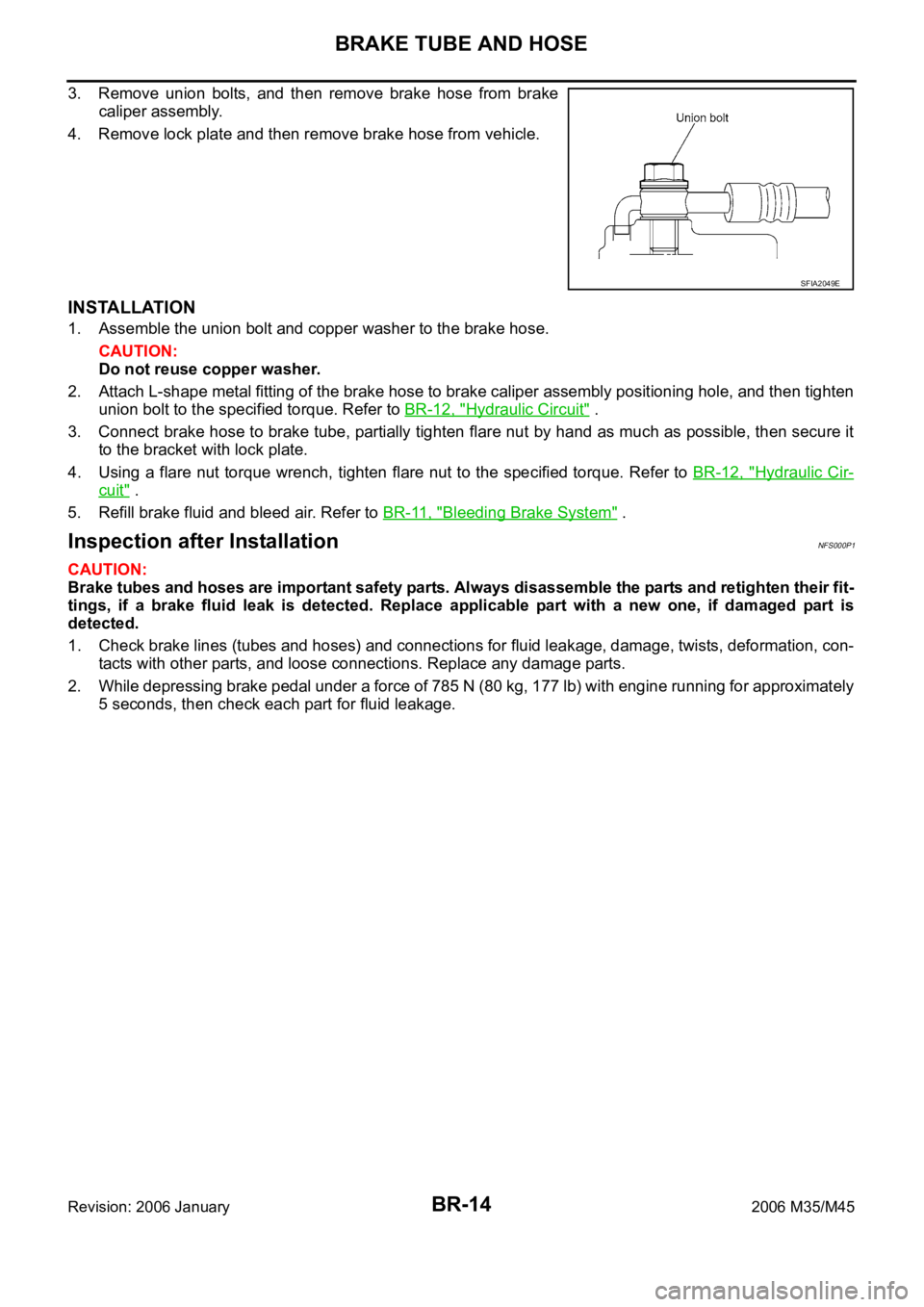
BR-14
BRAKE TUBE AND HOSE
Revision: 2006 January2006 M35/M45
3. Remove union bolts, and then remove brake hose from brake
caliper assembly.
4. Remove lock plate and then remove brake hose from vehicle.
INSTALLATION
1. Assemble the union bolt and copper washer to the brake hose.
CAUTION:
Do not reuse copper washer.
2. Attach L-shape metal fitting of the brake hose to brake caliper assembly positioning hole, and then tighten
union bolt to the specified torque. Refer to BR-12, "
Hydraulic Circuit" .
3. Connect brake hose to brake tube, partially tighten flare nut by hand as much as possible, then secure it
to the bracket with lock plate.
4. Using a flare nut torque wrench, tighten flare nut to the specified torque. Refer to BR-12, "
Hydraulic Cir-
cuit" .
5. Refill brake fluid and bleed air. Refer to BR-11, "
Bleeding Brake System" .
Inspection after InstallationNFS000P1
CAUTION:
Brake tubes and hoses are important safety parts. Always disassemble the parts and retighten their fit-
tings, if a brake fluid leak is detected. Replace applicable part with a new one, if damaged part is
detected.
1. Check brake lines (tubes and hoses) and connections for fluid leakage, damage, twists, deformation, con-
tacts with other parts, and loose connections. Replace any damage parts.
2. While depressing brake pedal under a force of 785 N (80 kg, 177 lb) with engine running for approximately
5 seconds, then check each part for fluid leakage.
SFIA2049E
Page 1290 of 5621
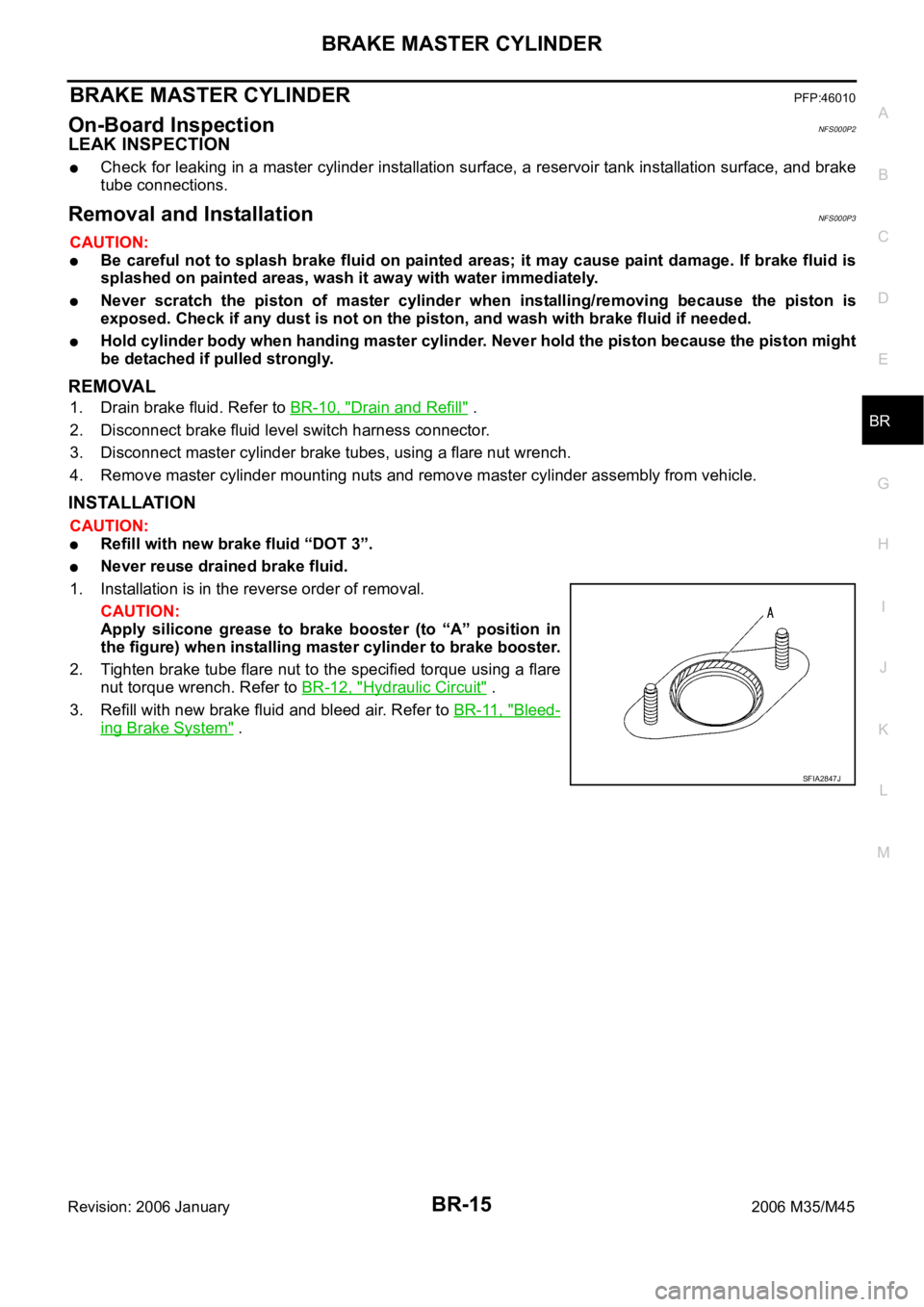
BRAKE MASTER CYLINDER
BR-15
C
D
E
G
H
I
J
K
L
MA
B
BR
Revision: 2006 January2006 M35/M45
BRAKE MASTER CYLINDERPFP:46010
On-Board InspectionNFS000P2
LEAK INSPECTION
Check for leaking in a master cylinder installation surface, a reservoir tank installation surface, and brake
tube connections.
Removal and InstallationNFS000P3
CAUTION:
Be careful not to splash brake fluid on painted areas; it may cause paint damage. If brake fluid is
splashed on painted areas, wash it away with water immediately.
Never scratch the piston of master cylinder when installing/removing because the piston is
exposed. Check if any dust is not on the piston, and wash with brake fluid if needed.
Hold cylinder body when handing master cylinder. Never hold the piston because the piston might
be detached if pulled strongly.
REMOVAL
1. Drain brake fluid. Refer to BR-10, "Drain and Refill" .
2. Disconnect brake fluid level switch harness connector.
3. Disconnect master cylinder brake tubes, using a flare nut wrench.
4. Remove master cylinder mounting nuts and remove master cylinder assembly from vehicle.
INSTALLATION
CAUTION:
Refill with new brake fluid “DOT 3”.
Never reuse drained brake fluid.
1. Installation is in the reverse order of removal.
CAUTION:
Apply silicone grease to brake booster (to “A” position in
the figure) when installing master cylinder to brake booster.
2. Tighten brake tube flare nut to the specified torque using a flare
nut torque wrench. Refer to BR-12, "
Hydraulic Circuit" .
3. Refill with new brake fluid and bleed air. Refer to BR-11, "
Bleed-
ing Brake System" .
SFIA2847J